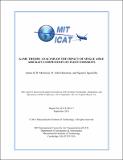Game Theory Analysis of the Impact of Single Aisle Aircraft Competition on Fleet Emissions
Author(s)
Morrison, James; Hansman, R. John; Sgouridis, Sgouris
Downloadmorrison-atio-2011.pdf (2.468Mb)
Terms of use
Metadata
Show full item recordAbstract
To meet aviation’s CO2 emission reduction targets while maintaining mobility in the face
of increasing effective fuel costs, technology innovation will be required. The single aisle
commercial aircraft market segment is the largest by quantity and value, but has the longest
running product lines. New aircraft programs offer the largest potential gains in fuel
efficiency, but are risky and require large capital investments. Re-engining existing
airframes reduces risk and capital requirements, but offers lower potential fuel burn
improvements. Incremental improvements to existing aircraft lines may entail the lowest
risk. It is hypothesized that competition has important effects on manufacturers’ decisions to
innovate and that these effects must be considered when designing policies to reduce CO2
emissions from aviation. An aircraft program valuation model is developed to estimate
expected payoffs to manufacturers under different competitive scenarios. A game theory
analysis demonstrates how the incentives for manufacturers to innovate may be altered by
subsidies, technology forcing regulations, increased effective fuel costs, the threat of new
entrants, and long-term competitive strategies. It is shown that increased competition may
result in incumbent manufacturers producing re-engined aircraft while increased effective
fuel costs may result in new aircraft programs. Incumbents’ optimal strategies may be to
delay the entry into service of new single aisle aircraft until 2020-24, unless technology
forcing regulations are implemented.
Date issued
2011-09-20Series/Report no.
ICAT;2011-7
Keywords
CO2 emission, air transportation, fuel costs, game theroy analysis
Collections
The following license files are associated with this item: